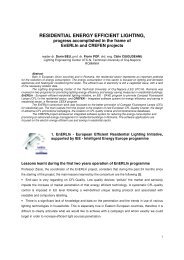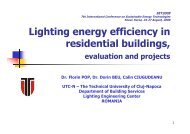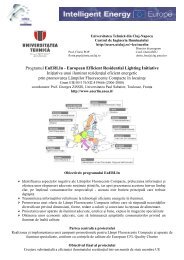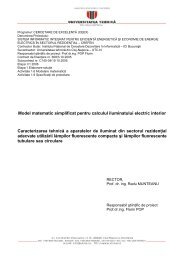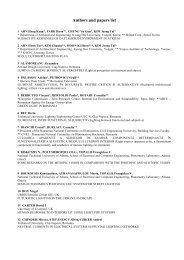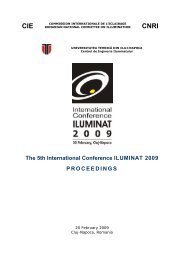1 June 2007 Cluj-Napoca, Romania - Lighting Engineering Center ...
1 June 2007 Cluj-Napoca, Romania - Lighting Engineering Center ...
1 June 2007 Cluj-Napoca, Romania - Lighting Engineering Center ...
You also want an ePaper? Increase the reach of your titles
YUMPU automatically turns print PDFs into web optimized ePapers that Google loves.
International Conference ILUMINAT <strong>2007</strong><br />
ABSTRACT<br />
GREENLIGHT IN ROMANIA<br />
RUS Coriolan Titus, CORHA Cornel<br />
ARCE – <strong>Romania</strong>n Agency for Energy Conservation<br />
The European GreenLight programme is an on-going initiative from the European Commission<br />
whereby voluntary organisations commit to adopting energy-efficient lighting measures when these<br />
are profitable and maintain or improve lighting quality. At the time of this writing, 93 public and private<br />
organisations have signed the GreenLight partnership. Major players have joined the movement and<br />
several GreenLight upgrades have got off the ground. Given its success, the programme was<br />
extended in 2002 to the Candidate Countries, including <strong>Romania</strong> where the <strong>Romania</strong>n Agency for<br />
Energy Conservation (ARCE) has agreed to act as Greenlight National Contact Point. ARCE has<br />
volunteered to promote the programme and enrol the first <strong>Romania</strong>n Partners.<br />
INTRODUCTION<br />
The GreenLight programme is an on-going voluntary programme whereby private and public<br />
organisations (referred to as Partners) commit to adopting energy-efficient lighting measures when (1)<br />
the cost of these measures is repaid by the associated savings 1 and (2) lighting quality is maintained<br />
or improved. In return for their commitment, not only do these Partners benefit from the savings, but<br />
they also receive broad public recognition for their effort in protecting the environment.<br />
The GreenLight programme started in 2000 upon the European Commission’s initiative (EC),<br />
with support from the national energy agencies of 13 Member States, plus Norway (NOVEM 1999). At<br />
the end of 2002, the programme was opened to the Candidate Countries, including <strong>Romania</strong> where<br />
the Agency for Energy Conservation (ARCE) agreed to promote the programme.<br />
The objective of this paper is to introduce the GreenLight programme to potential <strong>Romania</strong>n<br />
Partners, showing them some pertaining GreenLight success stories.<br />
WHAT IS THE GREENLIGHT PROGRAMME?<br />
The GreenLight programme helps voluntary non - residential electricity consumers (public or private),<br />
referred to as Partners, save money and reduce pollution by increasing the energy efficiency of their<br />
lighting. The core of the programme is a Registration Form, signed by the Partner and the<br />
Commission, in which the Partner commits to:<br />
For existing spaces:<br />
Either upgrade at least 50% of the spaces owned or on long term leases (5 years or more)<br />
where the investment is profitable or, alternatively, reduce the total aggregate lighting electricity<br />
consumption by at least 30%.<br />
For determining if an energy-efficient lighting investment passes the profitability test, the<br />
Partner can choose either to use as criterion (1) an Internal Rate of Return 2 (IRR) of 20% calculated<br />
over a period of 15 years or alternatively (2) the Least Life Cycle Cost rule over the project’s lifetime<br />
(minimum 5 years).<br />
The least Life Cycle Cost rule consists in accepting an energy-efficient lighting investment<br />
when the resulting Net Present Value 3 (NPV) of the investment is above or equal to 0.<br />
For new spaces:<br />
New installations must be chosen so that no alternative installation exists that would:<br />
• maintain or improve the lighting quality provided by the chosen installation and<br />
1 GreenLight applies to 50% of the eligible upgrades. Eligible upgrades are those yielding an Internal Rate of Return above 20%.<br />
2 The Internal Rate of Return is the interest rate that equates the present value of expected future cash flows to the initial cost of<br />
the project. Expressed as a percentage, IRR can be easily compared with loan rates to determine an investment’s profitability.<br />
For a stream of equal cash flows, an IRR of 20% over a 15 - year period corresponds to a payback time of 4.7 years.<br />
3 The Net Present Value is the total cash flow that the project generates over its lifetime, including first costs (counted<br />
negatively), with discounting applied to cash flows that occur in the future (money savings, counted positively).<br />
32 - 1



